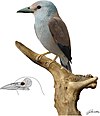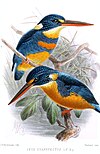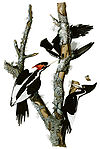Trachyphonus
| Trachyphonus | |
|---|---|

| |
| Red-and-yellow barbet Trachyphonus erythrocephalus | |
| Scientific classification | |
| Domain: | Eukaryota |
| Kingdom: | Animalia |
| Phylum: | Chordata |
| Class: | Aves |
| Order: | Piciformes |
| Family: | Lybiidae |
| Subfamily: | Trachyphoninae |
| Genus: | Trachyphonus Ranzani, 1821 |
| Species | |
|
Trachyphonus darnaudii | |
The African terrestrial barbets are the bird genus Trachyphonus in the African barbet family (Lybiidae), which was formerly included in the Capitonidae and sometimes in the Ramphastidae. These birds are more terrestrial than the other African barbets and differ in some other respects too; they are thus separated in a monotypic subfamily Trachyphoninae.
Species in taxonomic sequence
[edit]The genus contains 6 extant species:
| Image | Scientific name | Common Name | Distribution |
|---|---|---|---|
 |
Yellow-billed barbet | Trachyphonus purpuratus | Angola, Benin, Burundi, Cameroon, Central African Republic, Republic of the Congo, Democratic Republic of the Congo, Ivory Coast, Equatorial Guinea, Gabon, Ghana, Guinea, Kenya, Liberia, Nigeria, Rwanda, Sierra Leone, South Sudan, Togo, and Uganda. |
 |
Crested barbet | Trachyphonus vaillantii | Angola, Botswana, Burundi, Democratic Republic of the Congo, Eswatini, Malawi, Mozambique, Namibia, Rwanda, South Africa, Tanzania, Uganda, Zambia, and Zimbabwe. |
 |
Yellow-breasted barbet | Trachyphonus margaritatus | Burkina Faso, Chad, Djibouti, Eritrea, Ethiopia, Mali, Mauritania, Niger, Nigeria, Somalia, and Sudan. |
 |
Red-and-yellow barbet | Trachyphonus erythrocephalus | l Kenya to north-east Tanzania. |
 |
D'Arnaud's barbet | Trachyphonus darnaudii | West Africa |
 |
Usambiro barbet | Trachyphonus usambiro [1] | Kenya and northern Tanzania, |
Extinct taxa
[edit]The Early to Middle Miocene genus Capitonides from Europe, as well as "CMC 152", a distal carpometacarpus from the Middle Miocene locality of Grive-Saint-Alban (France), have been placed in this genus,[2] but this move is not widely accepted. In the case of "CMC 152", this may be more warranted as this fragment differs from Capitonides and is more similar to extant (presumably Old World) barbets.[3]
References
[edit]- ^ "Species Updates – IOC World Bird List". Retrieved 2021-06-18.
- ^ Mlíkovský, Jirí (2002): Cenozoic Birds of the World, Part 1: Europe. Ninox Press, Prague. ISBN 80-901105-3-8 PDF fulltext Archived 2011-05-20 at the Wayback Machine
- ^ Ballmann, Peter (1969): Les Oiseaux miocènes de la Grive-Saint-Alban (Isère) [The Miocene birds of Grive-Saint-Alban (Isère)]. Geobios 2: 157–204. [French with English abstract] doi:10.1016/S0016-6995(69)80005-7 (HTML abstract)








